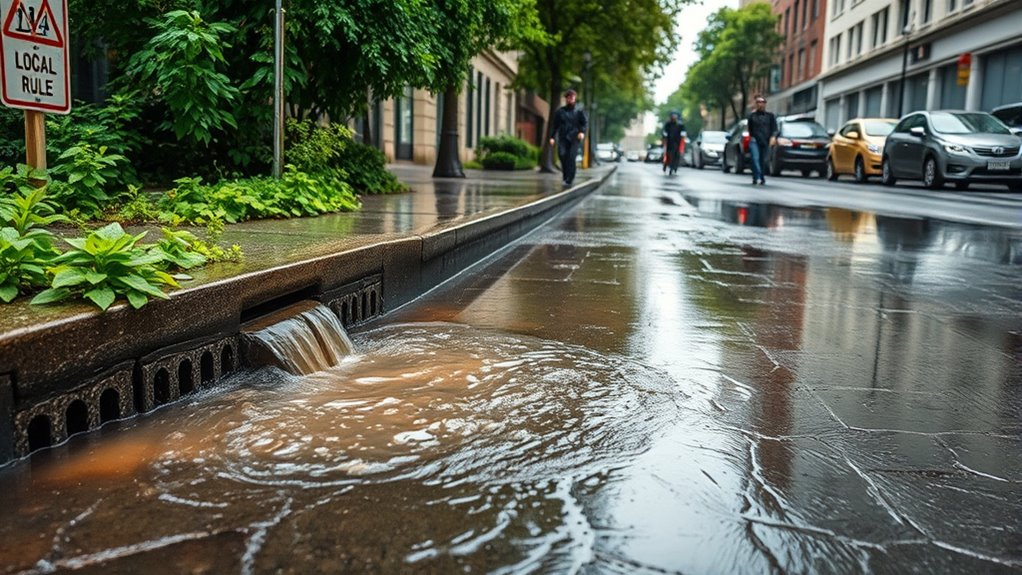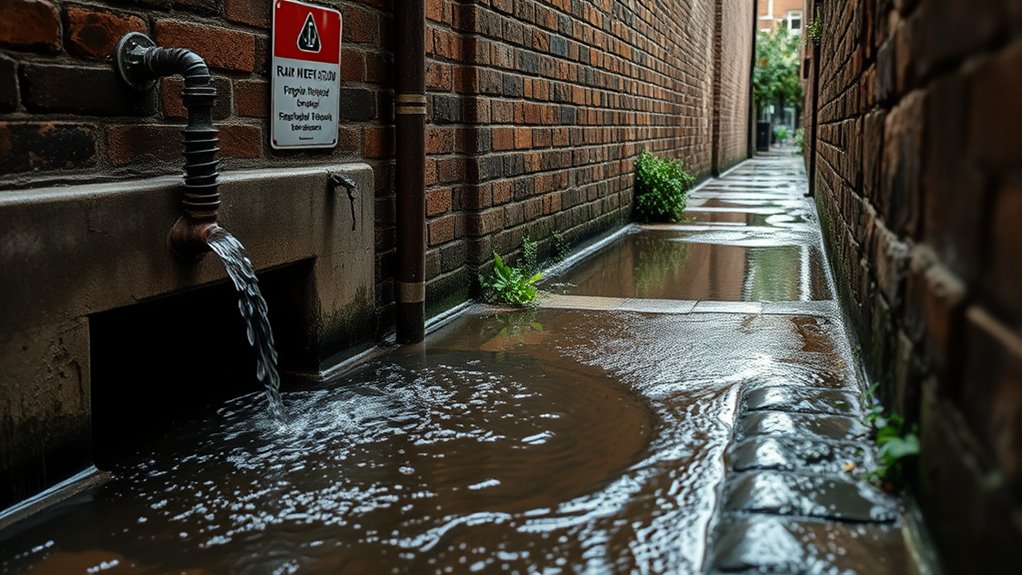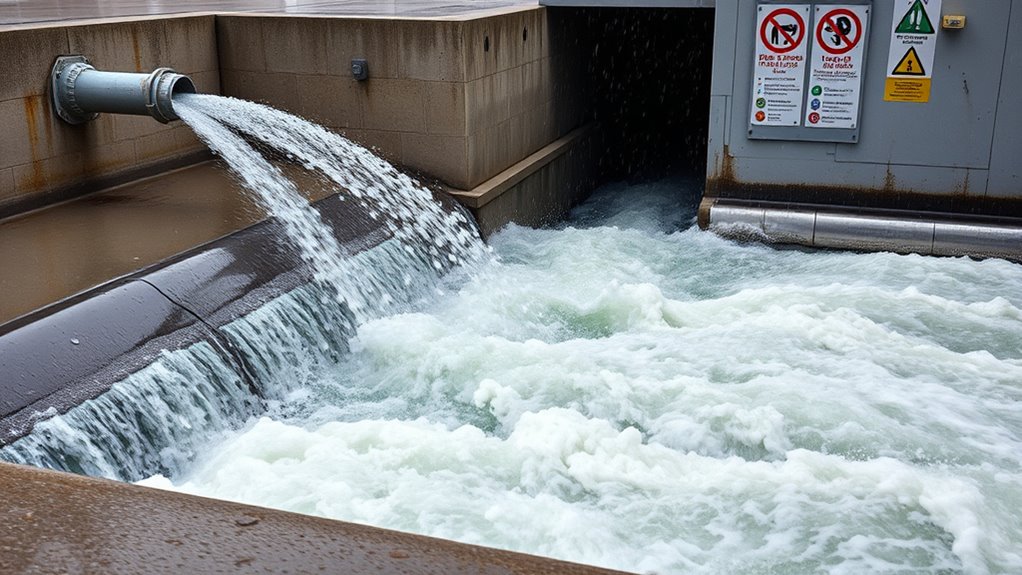To manage rainwater effectively, you need to understand how overflow and backwash happen and follow local rules. Overflow occurs when drainage can’t handle heavy rain, causing flooding and property damage. Backwash results from blockages that increase system pressure and cause leaks. By installing proper drainage, maintaining gutters, and following community regulations, you can reduce these risks. If you want to learn more about how to keep your system efficient and compliant, keep exploring these key practices.
Key Takeaways
- Proper drainage design and regular maintenance prevent overflow and reduce pollution runoff into natural water bodies.
- Backwash issues caused by debris blockages can damage pipes; routine inspections and filters help mitigate risks.
- Local regulations govern rainwater discharge, system installation, and reuse, requiring permits and compliance to avoid penalties.
- Community participation, including gutter cleaning and reporting system issues, supports effective rainwater management.
- Best practices include designing for adequate capacity, slopes, high-quality materials, and scheduled maintenance routines.
Understanding Rainwater Overflow and Its Impact

Have you ever wondered what happens when rainwater exceeds a drainage system’s capacity? When this occurs, the excess water can’t flow through the pipes or channels fast enough, leading to overflow. This spillovers onto streets, sidewalks, or nearby land, causing flooding and water pooling. Such overflow can damage infrastructure, erode soil, and disrupt daily activities. It also creates safety hazards, like slippery surfaces and hidden hazards beneath pooled water. Overflows can carry pollutants from urban areas into rivers and lakes, harming ecosystems. Recognizing this, it’s vital to understand how drainage systems work and their limits. Proper management helps prevent overflow, reducing risks, protecting property, and safeguarding the environment from the adverse effects of excess rainwater. Effective drainage management plays a crucial role in minimizing these impacts.
Causes and Consequences of Backwash in Drainage Systems

Backwash in drainage systems often happens when blockages or clogs trap debris, causing water to push back. This increased pressure can lead to structural damage over time. Understanding these causes helps you prevent costly repairs and maintain efficient rainwater flow. Regular maintenance and inspection of drainage components can prevent backwash issues and ensure a smooth flow of water.
Blockages and Clogs Formation
Blockages and clogs in drainage systems often originate from the accumulation of debris, dirt, and organic matter, which can quickly obstruct water flow. Over time, leaves, twigs, and sediment settle and stick, narrowing the pipes. This buildup causes water to back up, increasing the risk of overflow and backwash. Regular maintenance helps prevent these issues, but neglecting it accelerates clog formation. Here’s a quick look at common causes:
| Cause | Effect | Prevention |
|---|---|---|
| Organic matter buildup | Blockages and slow drainage | Regular cleaning and filters |
| Sediment accumulation | Reduced pipe capacity | Install screens and traps |
| Debris from storms | Sudden clogs and backups | Clear debris promptly |
| Grease and oils | Pipe narrowing and odor issues | Avoid pouring grease down drains |
| Small objects | Complete blockages | Use covers and grates |
| Lack of maintenance | Increased likelihood of severe clogs | Schedule routine inspections |
Increased System Pressure
When drainage systems become clogged or obstructed, pressure inside the pipes can increase rapidly, leading to backwash. This heightened pressure forces water and debris backward, potentially spilling out of joints or vents. Several factors cause this pressure increase, including heavy rainfall, improper slope, or blockages that restrict flow. As pressure builds, the system’s ability to carry water diminishes, risking overflow and contamination. Increased pressure also stresses pipe joints and fittings, making leaks more likely. If unaddressed, this can escalate into larger system failures. Proper system maintenance and regular inspections are crucial for early detection and prevention of backwash incidents. Managing pressure helps maintain system integrity, reduces backwash incidents, and ensures rainwater is effectively directed away without causing damage or contamination.
Structural Damage Risks
If backwash occurs in your drainage system, it can cause significant structural damage over time. The force of water pushing back can weaken pipes, joints, and foundations, leading to cracks or collapses. Continuous backwash exposes your system to erosion, undermining its integrity and causing leaks that may damage walls, floors, or basements. Over time, accumulated debris and sediment from backwash can clog pipes, increasing pressure and risking bursts. This damage not only requires costly repairs but also compromises your property’s safety. Additionally, improper water management can exacerbate these issues and lead to more frequent backwash problems. If ignored, backwash-related issues can result in severe structural failures, affecting overall stability. Regular maintenance and proper system design are essential to prevent backwash and protect your drainage infrastructure from these serious risks.
Common Challenges in Rainwater Management

Managing rainwater effectively presents several common challenges that can hinder ideal drainage and water conservation. One major issue is clogged gutters and drains, which cause overflow and water damage. Debris buildup reduces flow capacity, leading to pooling around your property. Another challenge is inadequate slope or grading, which prevents water from flowing away properly, increasing erosion risks. Insufficient storage capacity can also lead to frequent overflow during heavy rains. Additionally, improper installation of drainage systems can create backups or leaks. Limited space for rainwater harvesting or infiltration can further complicate management efforts. These obstacles require regular maintenance, proper planning, and awareness of your site’s unique conditions to guarantee effective rainwater control and avoid costly damages. Regular inspection and proper installation techniques are essential for long-term effectiveness.
Essential Local Regulations for Rainwater Disposal

Understanding local regulations for rainwater disposal is essential to guarantee your drainage practices comply with legal standards and protect your property. Many areas have specific rules regarding rainwater runoff, including limits on discharge rates and requirements for filtration or reuse. You need to check if permits are necessary for installing drainage systems or redirecting water. Some jurisdictions restrict discharging rainwater onto neighboring properties or public streets without approval. Additionally, there may be rules about the types of materials you can use or how close your system can be to foundations and utilities. Failing to follow these regulations can result in fines or legal disputes. Always consult your local building department or environmental agency to ensure your rainwater disposal methods meet all requirements. Recognizing and identifying rainwater management signs can help ensure compliance and prevent issues.
Best Practices for Installing and Maintaining Drainage Systems

Proper installation and ongoing maintenance are essential to ensuring your drainage system functions effectively and lasts over time. Start by choosing the right materials suited to your land’s conditions and rainfall levels. Confirm pipes are laid with proper slopes to promote efficient water flow and prevent pooling. Avoid sharp bends that can cause blockages and use quality fittings to minimize leaks. Regularly inspect your system for debris, sediment, or damage, and clear any obstructions promptly. Secure connections and check for signs of corrosion or wear, replacing parts as needed. Keep catch basins and filters clean to prevent clogs. Properly grading your property directs water away from structures, reducing stress on the system. Materials and fuel primers are also important considerations for drainage systems that incorporate pumps or other active components. Consistent care maximizes performance, prevents costly repairs, and prolongs your drainage system’s lifespan.
Preventive Measures to Reduce Overflow and Backwash Risks

To prevent overflow and backwash issues, you should regularly inspect your drainage systems for blockages or damage. Designing your drainage setup properly guarantees water flows smoothly and reduces risks. Additionally, sticking to scheduled maintenance routines keeps your system in ideal condition and helps catch problems early. Regularly monitoring local regulations and rules can also ensure your system complies with community standards and prevents potential legal issues.
Regular System Inspections
Have you ever considered how regular system inspections can prevent costly overflow and backwash issues? Routine checks help identify problems early, saving you money and headaches. To guarantee your system stays in top shape, focus on:
- Inspecting pipes and connections for leaks or blockages
- Clearing debris from filters and screens
- Checking the flow rates to spot irregularities
- Testing valves and pumps for proper operation
- Ensuring proper system calibration maintains optimal performance
Perform inspections at least quarterly, especially after heavy storms. Catching small issues before they escalate keeps your system running smoothly. Regular maintenance also extends the lifespan of your rainwater management setup, reducing unexpected failures. By staying proactive, you minimize overflow risks and backwash problems, ensuring your system functions efficiently when you need it most.
Proper Drainage Design
Are you aware that a well-designed drainage system is essential for preventing overflow and backwash issues? Proper drainage design guarantees rainwater flows efficiently away from your property, reducing the risk of water buildup. Start by planning for adequate capacity, considering peak rainfall events to prevent overflows. Incorporate slopes and channels that direct water swiftly toward designated outlets, avoiding stagnation. Use high-quality materials that resist clogging and corrosion. Install filters or screens at entry points to prevent debris from causing blockages. Maintain clear pathways for water flow, avoiding sharp bends or constrictions that could slow drainage. Effective design also includes strategic placement of outlets to prevent backwash into your system. By paying attention to these details, you minimize risks and protect your property from water damage.
Scheduled Maintenance Routines
Regularly scheduled maintenance guarantees your drainage system functions effectively, preventing overflow and backwash issues. By staying proactive, you catch problems early and ensure smooth operation.
To keep your system in top shape, consider these routines:
- Inspect and clean gutters and downspouts monthly to prevent blockages.
- Remove debris and sediment from filters and screens regularly.
- Check for leaks or cracks in pipes and repair them promptly.
- Test overflow valves and backwash systems to confirm proper operation.
Implementing these steps consistently minimizes risks of overflows and backwash, saving you costly repairs later. Staying vigilant with maintenance protects your property and ensures rainwater is managed efficiently. Make maintenance a habit, and your drainage system will serve you reliably through every storm.
Community Roles and Responsibilities in Rainwater Management

Effective rainwater management depends on the active participation of communities, as local residents play a vital role in protecting their environment. You need to stay informed about local rules and participate in community efforts like clean-up drives and awareness campaigns. Installing rain barrels and maintaining gutters help reduce runoff and prevent blockages. It’s also your responsibility to report issues such as overflowing drains or blocked inlets promptly. Collaborate with neighbors to guarantee shared systems are functioning properly and adhere to zoning regulations. Educating others about sustainable practices encourages wider community involvement. Your proactive engagement helps prevent flooding, reduces pollution, and preserves local water sources. By working together, you create a resilient community that manages rainwater effectively and safeguards the environment for everyone.
Frequently Asked Questions
How Does Climate Change Influence Rainwater Overflow Frequency?
Climate change increases the frequency of rainwater overflow by causing more intense and unpredictable storms. As these heavy rains hit your area, your drainage systems are overwhelmed more often, leading to frequent overflows. You might notice more flooding or backups in your infrastructure. To adapt, you should stay informed about local weather patterns and consider upgrading your rainwater management systems to handle larger, more frequent storms effectively.
Are There Specific Materials Recommended for Durable Drainage Systems?
Think of durable drainage systems as the backbone of your rainwater management. You should choose materials like high-density polyethylene (HDPE), concrete, or fiberglass, which stand strong against weather and wear. These materials act like shields, resisting corrosion and cracking over time. By selecting the right, tough materials, you guarantee your system remains reliable, preventing overflow and backwash issues, even during heavy rains or climate change impacts.
What Are the Financial Incentives for Proper Rainwater Management?
You can benefit financially from proper rainwater management through incentives like tax credits, rebates, and grants offered by local governments or environmental programs. These incentives encourage you to install systems such as rain barrels, permeable pavements, or green roofs, reducing runoff and water bills. By investing in effective rainwater management, you not only save money but also contribute to environmental conservation and compliance with local regulations.
How Can Residents Participate in Local Rainwater Management Initiatives?
You can participate in local rainwater management initiatives by attending community meetings, volunteering for cleanup events, and implementing rain gardens or permeable pavements on your property. Reach out to your local authorities to learn about programs or incentives available. Spread awareness among neighbors, share ideas, and advocate for sustainable practices. Your active involvement helps reduce flooding, conserves water, and promotes a healthier environment for everyone.
What Are the Long-Term Environmental Benefits of Effective Rainwater Control?
Effective rainwater control helps protect ecosystems by reducing pollution runoff and preventing flooding. Your efforts in managing rainwater lead to healthier soil, cleaner waterways, and preserved wildlife habitats. Over time, you’ll notice fewer property damages and lower water treatment costs. By contributing to these practices, you actively support a sustainable environment, ensuring clean water and resilient communities for future generations. Your actions truly make a lasting positive impact.
Conclusion
By understanding and following local rules, you can keep your rainwater system flowing smoothly like a well-oiled machine. Preventing overflow and backwash isn’t just about avoiding messes—it’s about safeguarding your property and community. Think of your drainage system as the lifeblood of your home, and with proper care, it’ll keep running strong through every storm. Stay proactive, follow best practices, and make rainwater management your community’s steady heartbeat.









